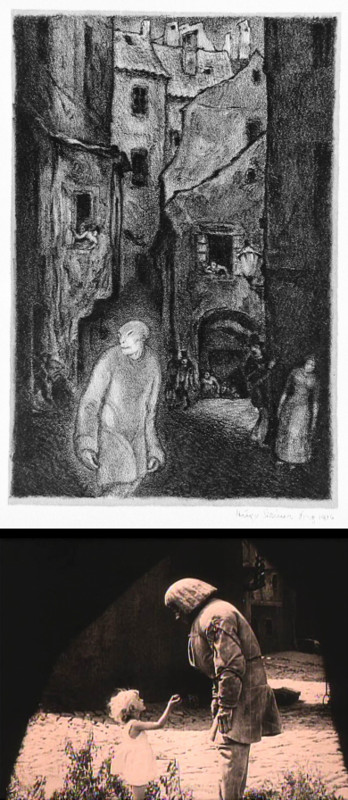Masterworks of Expressionist Cinema: The Golem and its Avatars
24 Aug 2013 - 16 Feb 2014

Top: Hugo Steiner Prag, Czechoslovakia, active Germany and United States, 1880–1945, Die Erscheinung des Golem (The Appearance of the Golem), 1915–16, From the portfolio Der Golem (The Golem) lithograph, 7 5/16 x 4 13/16 in.; Sheet: 13 5/16 x 9 5/8 in. The Robert Gore Rifkind Center for German Expressionist Studies, M.82.287.68f. © The Estate of Hugo Steiner-Prag, photo © Museum Associates/LACMA
Bottom: Paul Wegener (director), Germany, 1874–1948, Carl Boese (director) Germany, 1887–1958, Film still from Der Golem: Wie er in die Welt kam (The Golem: How He Came into the World), 1920, Written by Paul Wegener and Henrik Galeen, Produced by Paul Wegener, B&W, silent.
Bottom: Paul Wegener (director), Germany, 1874–1948, Carl Boese (director) Germany, 1887–1958, Film still from Der Golem: Wie er in die Welt kam (The Golem: How He Came into the World), 1920, Written by Paul Wegener and Henrik Galeen, Produced by Paul Wegener, B&W, silent.
MASTERWORKS OF EXPRESSIONIST CINEMA: THE GOLEM AND ITS AVATARS
24 August 2013 – 16 February 2014
A golem—a large, powerful creature made of clay—is a figure from Jewish folklore. The exhibition includes a wide variety of works that address the golem legend: footage from Paul Wegener’s 1920 film Der Golem: Wie er in die Welt kam (The Golem: How He Came into the World); photography; vintage posters; illustrations from the 1915 novel The Golem; modern prints; a designer gown, and comic books.
Wegener’s film, based on the most well-known version of the legend, is set in sixteenth-century Prague, where a cruel emperor persecutes Jewish residents. Rabbi Loew fashions the Golem and brings him to life with a mystical amulet; the creature then rampages through the city, crushing the enemies of the Jews. The monster begins to experience glimmers of human emotion in the aftermath of destruction, before he is disabled, when a little girl removes the amulet and the Golem crumbles to dust.
The Golem legend had heightened currency in Europe during the 1920s, when anti-Semitism was on the rise.The idea of the golem, an inanimate object brought to life, remains potent today and can be seen as a metaphor for the artist’s creative process.
24 August 2013 – 16 February 2014
A golem—a large, powerful creature made of clay—is a figure from Jewish folklore. The exhibition includes a wide variety of works that address the golem legend: footage from Paul Wegener’s 1920 film Der Golem: Wie er in die Welt kam (The Golem: How He Came into the World); photography; vintage posters; illustrations from the 1915 novel The Golem; modern prints; a designer gown, and comic books.
Wegener’s film, based on the most well-known version of the legend, is set in sixteenth-century Prague, where a cruel emperor persecutes Jewish residents. Rabbi Loew fashions the Golem and brings him to life with a mystical amulet; the creature then rampages through the city, crushing the enemies of the Jews. The monster begins to experience glimmers of human emotion in the aftermath of destruction, before he is disabled, when a little girl removes the amulet and the Golem crumbles to dust.
The Golem legend had heightened currency in Europe during the 1920s, when anti-Semitism was on the rise.The idea of the golem, an inanimate object brought to life, remains potent today and can be seen as a metaphor for the artist’s creative process.
